A teaser at the end of last week’s post suggesting more to come about changes to the layout peaked Chris Mears’s interest, so, let’s not torment him any longer.
After much debate and procrastination, I decided to alter the yard area above the workbench -again.
I considered changes to the track arrangement but chose to leave it as is, having concluded things were as good as they could be given the available space and my desire not to overcrowd the scene. If I have learned nothing else from working in quarter-inch scale, I now understand how easy it is to overcrowd a scene with track, which takes up far more space than those working in HO or N scales can ever imagine, and can produce a toy-like effect that destroys any sense of realism. As I suggested last week, the key to this scale is restraint.
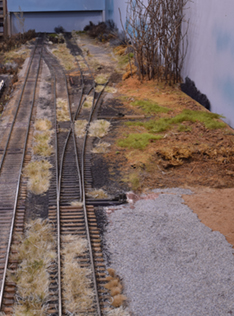
This mismatch between the open service road and crowded scenery was jarring. There was no easy way to extend the road.
Despite prior efforts, the scenery at the back of the yard still didn’t fit well with the rest of the layout, which is what truly bothered me. If you recall the photo from last week, there is a wide service road that runs along the yard tracks. As seen in the foreground of this photo, I started the road in the middle section and planned to extend it all the way to the end of the layout.
The problem this time revolved around the lack of space for this road next to the yard track. The low hill I modeled to ease the transition from layout surface to the backdrop intruded as did the remnants of the decommissioned turnout. The scale height trees I placed next to the backdrop brought the background forward visually and greatly reduced the feeling of depth. All of this was a jarring contrast to the open area next to the old station platform seen below. The background scenery is still incomplete but you get the sense of where the scene is going.
I’ve discovered that it’s often better to start with a clean slate than to work around pre-existing conditions, so I stripped off the old scenery in 15-20 minutes of work (photo above). Later I removed the rails from the old turnout. I initially left them in place for the visual effect but the railroad would have removed this turnout completely to eliminate a safety hazard. I patched the gap with the stock rail by moving it over and trimming to length. It already had a feeder wire, so problem solved electrically and the track is back in service.
There is still much work to be done but even with the service road in its raw state, I can see a greater continuity across the entire layout, so I feel this is the right course. The road extends into the yard as it should with room to stretch out to its proper width. To soften the hard transition to the backdrop, I will continue the chain link fence from the mill across the length of the entire scene, letting it peek in and out of a generous quantity of weeds, shrubs and more appropriately sized trees. To prevent the background from coming too far forward visually, I need to pay greater attention to the proportions, textures and coloring so that it stays back where it belongs.
I have high hopes this will finally resolve the conflict I’ve long felt about this area and bring a sense of openness to the scene.
On the surface this solution should have been obvious from the start. Observe the prototype, then model what you see as closely as possible. This multi-year soap opera of revolving fixes demonstrates how rigid and convoluted one’s thinking can become. If you would like an overview of the progression of this area, I’ve linked to the archive posts below.
Now, Mr. Mears, about all that large scale masonry that keeps showing up on your blog? I’m curious.
Regards,
Mike
Archive Links
One Layout or Two?
Weeding The Yard
An Update Or Two
Scenery Progress
The Power Of Empty
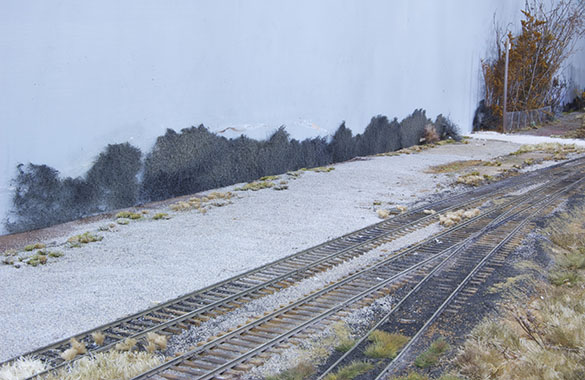
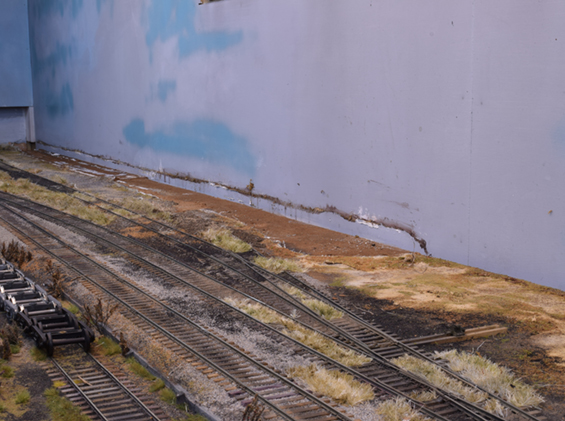
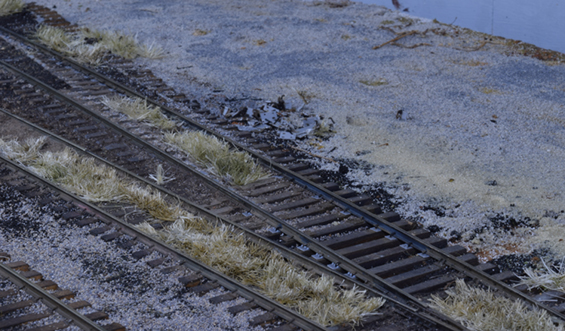
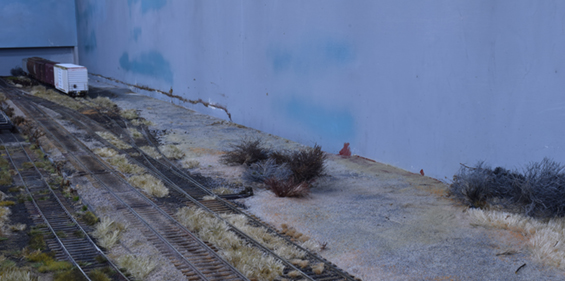
Ha! Terrific subject line and opening paragraph. I enjoyed that.
When, in your previous post, you alluded to more to come I felt like I appreciated your thoughts on the two layouts in one issue and why and how it bugged you. Reflecting on it I wondered if your action might be to remove one half altogether to focus your attention on the half that worked. I was curious if, while extreme sounding, might be the next step in a design-edit-design-edit rhythm for you. Seeing what you did reveals a place in the middle where you’re confronting exactly the element that seemed to be undermining the scene overall. Intelligent, wise, and focused. I like it.
I hope I’m not being too bold in asking if you could remove more track from the scene? I like the focus on increasing the white space in the area and concentrating those elements that are important to you and with that in mind wondered if there was a way to remove one more track? I don’t have a particular one in mind but wanted to ask. For the sake of example, maybe instead of just lifting the one siding as you did to perhaps remove both and move the road directly in line with the loop siding? I can’t apologize enough for my bold question and I really have no place in asking this (i.e. it’s your work not mine) and my interest here is academic and nothing more. Just curious.
As for the large scale masonary I don’t know where it’s going but then again, I do. In all of my efforts to better understand where I was headed in terms of my own work I was still thinking in terms where I couldn’t escape the prototype to layout relationship. Lost in that was any time spent on finding projects that made me happy. I’d find myself reading about a project in places like Russ Reinberg’s forum (finescalerr.com) and see a technique I wanted to try. In each of these techniques I saw something that I identified with as something that I’d enjoy doing. I’d be poised to try it myself but then talk myself out “because it’s in a large scale and I’ll never have room for a layout in that large a scale”. Not only was I missing out on work I enjoyed but I wasn’t exactly offsetting it with that layout either. I feel like I’m turning my approach on its head. I want to play around with a pile of techniques I’m learning from other modellers. I’m allowing myself to work in larger scales that I’ve never really fully explored before. When I’ve settled on enough things I find myself enjoying making I expect to see a common thread across those projects that I believe I could unify into a larger composite work. The prototype and theme are now less important than ever before but the work is already some of the most fun and probably leading up to be my finest to date. As for scale, I’m sold on working in something larger. If it never results in a model railway that might turn out to be fine. There will be trains and I think they’ll be ones I’m much more satisfied with. In the end, it’s a quotient I’m finding joy in.
But I’m rambling yet again and this is your blog. Not mine. I’ll trim this here.
Cheers
/chris
Hi Chris,
First off, there’s no need to apologize for your question. I’m thrilled that a reader is so engaged by the material and I welcome questions like yours as a chance to clarify and move the conversation forward. Thank you.
I considered the exact changes to the track that you outlined. I also considered removing that section of layout and turning it into a visible but unscenicked staging yard. I felt there were downsides to both options but have since found ways around those objections. Will there be future changes? Maybe, who knows? At this point I’m happy with how the scene will come together and how it will enhance the layout as a whole.
Your entire comment has provided much fuel for thought and rather than go on at length now, I will expand on these thoughts in next week’s post. for now I will simply say I have the utmost respect for the path you are on. Well said.
Regards,
Mike
Mike,
I think this removal of trackage is right along with your philosophy of modeling, and along the lines of less is more.
Did you think about simply removing the points of the turnout, and replacing it with solid rail? Often when the prototype removes a turnout from service it follows sequence like this; 1st lock the switch with a MOW lock (easy to put back into service); 2nd remove the points, and replace with regular rail, but keep the frog (a little harder to put back in service, but somehow this allows the RR to ‘write off’ the siding/spur for tax purposes, or that’s what I’ve been told); 3rd removal of frog and remaining rail to spur/siding (at this point it looks pretty permanent); 4th removal of turnout ties.
My point being that as modelers if we follow this process when we are thinking about removing trackage, we can critically think about how this will effect both operations, and aesthetics, while replicating the process that the prototype goes through.
I model in 1:29 outdoors, which takes up even more room that O scale, and I struggle with how much is too much room. Currently, my modeling plans are for a single station/town area that serves 1 industry (a feed mill 180′ x 150′), 4 #9 turnouts (per the prototype), but requires an area of 50′ x 8′ to effectively model the area without making everything look toy train like. As a former railroader, one of my biggest pet peeves in the hobby is seeing something crammed together to fit the space without allowing room for the ‘boring’ stuff.
Sorry forgot to sign the above post!
Craig